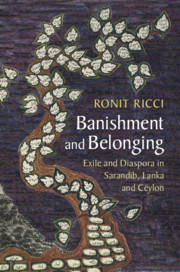Book contents
- Banishment and Belonging
- Asian Connections
- Banishment and Belonging
- Copyright page
- Contents
- Figures
- Maps
- A Note on Orthography and Manuscripts
- Acknowledgments
- Abbreviations
- Maps
- 1 Introduction
- 2 Diasporic Crossings: Malay Writing in Nineteenth-Century Ceylon
- 3 Remembering Java
- 4 “Ceyloned”: The View from the Other Shore
- 5 Exilic Journeys in Time, Place and Writing
- 6 Nabi Adam: The Paradigmatic Exile
- 7 Banishment and Interreligious Encounters: A Malay Ramayana
- 8 Ceylon Malays: Military and Literary Paths
- 9 Malay Writing in Ceylon: Roots and Routes
- Glossary
- Bibliography
- Index
7 - Banishment and Interreligious Encounters: A Malay Ramayana
Published online by Cambridge University Press: 11 November 2019
- Banishment and Belonging
- Asian Connections
- Banishment and Belonging
- Copyright page
- Contents
- Figures
- Maps
- A Note on Orthography and Manuscripts
- Acknowledgments
- Abbreviations
- Maps
- 1 Introduction
- 2 Diasporic Crossings: Malay Writing in Nineteenth-Century Ceylon
- 3 Remembering Java
- 4 “Ceyloned”: The View from the Other Shore
- 5 Exilic Journeys in Time, Place and Writing
- 6 Nabi Adam: The Paradigmatic Exile
- 7 Banishment and Interreligious Encounters: A Malay Ramayana
- 8 Ceylon Malays: Military and Literary Paths
- 9 Malay Writing in Ceylon: Roots and Routes
- Glossary
- Bibliography
- Index
Summary
When considering Lanka and banishment, one cannot but think of the Ramayana, a pivotal religious, cultural and literary influence across South and Southeast Asia for many centuries. In Java especially, a Ramayana textual tradition stretching back to the ninth century, the story’s visibility in carved images on sacred landmarks, and its popularity in performative traditions meant that it was widely known, interpreted and appreciated, including during and after Java’s widespread Islamization. This chapter asks whether the Ramayana – with its central theme of banishment to Lanka – played a role in the Malay exilic imagination. Did exiles and others, and their descendants, implicitly or explicitly connect (1) Selong, Sarandib and Lanka and (2) the story of Rama and Sita’s exile to the forest, and especially Sita’s banishment to Lanka, with their own plight? If they did, what meanings and roles did the Ramayana acquire? In exploring these questions the chapter considers nomenclature histories, exploring how different names that converge on the “same” site, can shape profoundly divergent imaginaries and perspectives.
- Type
- Chapter
- Information
- Banishment and BelongingExile and Diaspora in Sarandib, Lanka and Ceylon, pp. 149 - 180Publisher: Cambridge University PressPrint publication year: 2019



